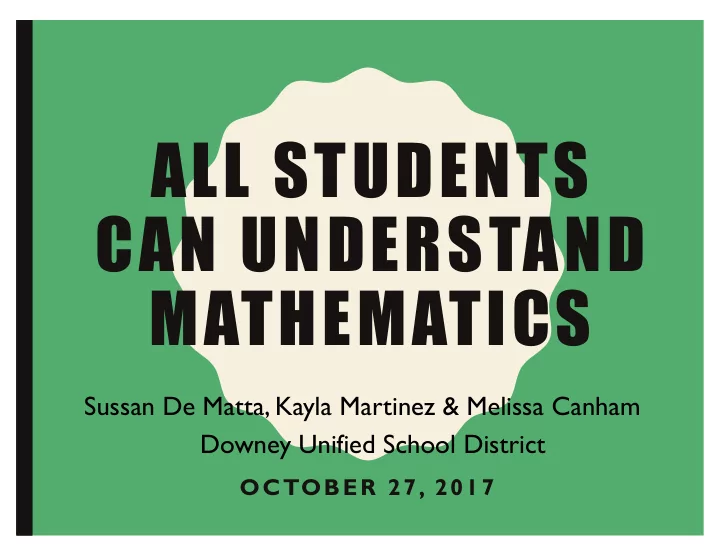

ALL STUDENTS CAN UNDERSTAND MATHEMATICS Sussan De Matta, Kayla Martinez & Melissa Canham Downey Unified School District OCTOBER 27, 2017
GOALS • Routines • Unpacking a Word Problem and Visualizations • Students’ Strategies and Sharing Out • Q & A
The ultimate goal is that students develop a disposition towards their mathematical learning which involves a sense of themselves as learners who construct mathematical meaning through engaging in mathematical activity, rather than experiencing mathematical instruction as the acquisition of isolated facts and procedures. This study has shown that for the participating pupils with learning difficulties this is a realistic and reasonable expectation, but the realization of this expectations is fundamentally dependent on the knowledge and beliefs of the teacher. Moscardini, 2010, p.136
RESEARCHERS THAT WILL HELP US TODAY • Leo Moscardini – ”I like it instead of maths”: how pupils with moderate learning difficulties in Scottish primary special schools intuitively solved mathematical word problems (2010) • Rachel Lambert - https://mathematizing4all.wordpress.com – I have a solution to share: Learning through equitable participation in a mathematics classroom (2011) • Their research has found: Students with disabilities can successfully solve story problems and develop complex thinking about mathematical relationships with the teacher’s knowledge of CGI.
COMMON COMPONENTS OF CGI / CCS-M CLASSROOMS l Problem solving is the focus of instruction; teachers pose a variety of problems. l Many problem-solving strategies are used to solve problems. Children decide how they should solve each problem. l Children communicate to their teachers and peers how they solved the problems. l Teachers understand children’s problem-solving strategies and use that knowledge to plan instruction.
The new evidence from brain research tells us that everyone, with the right teaching and messages, can be successful in math, and everyone can achieve at the highest levels in school. There are a few children who have very particular special educational needs that make math learning difficult, but for the vast majority of children any levels of school math are within their reach. Jo Boaler, Mathematical Mindsets, 2016
A TYPICAL DAY (K-5) • Routine – 10 to 20 minutes – Developing number sense – Reasoning and explaining thinking • Daily Lesson – 30 to 40 minutes • Closure/Debrief – 5 to 10 minutes
WHAT IS A ROUTINE? • 5 – 15 minutes during the opening of math time • Short lesson alongside (but not necessarily directly related to) the ongoing math curriculum • Provide students with meaningful ongoing practice with: – Computation – Number Sense – Place Value – Properties of Operations – Fractions – Standards for Mathematical Practice – Listening to others’ strategies – Infusion of language
SUSSAN – SDC 5TH
REFLECTION • How can/do you make this work in your classroom? • How can you modify in your classroom for students that have significant cognitive needs? –What different accommodations can support with implementation?
SCAFFOLDING TIPS • Sentence stems • Explicitly teach accountable talk • Vocabulary anchor chart • Have students sit together in an area with no distractions • Use simple visuals to introduce a routine • Build students’ confidence by starting with accessible problems for all and then increase the rigor • Make sure everyone shares • Wait time
THE POWER OF UNPACKING
KAYLA – UPPER GRADE SDC
UNPACKING THE PROBLEM – VISUALIZATION • Students with disabilities may need extra help visualizing story problems. Moscardini (2010) also recommends “chunking the presentation, or restating the problem slowly so that kids can think through each part, and possibly model it as you talk. –What moves did Kayla do to help with visualization? –How did the students respond?
DIFFERENTIATION • Number Choices • Manipulatives • Allowing the use of different strategies • Context • Grouping options
STRATEGIES • Some kids with disabilities have extensive practice with skill and drill mathematics, or being told what operation to use. For those kids, they need time to adapt to new expectations. They might guess quite a bit at first, or have trouble starting. If you continue to expect the kids to make meaning for themselves, they will eventually rise to the occasion. - Rachel Lambert
KAYLA – MONITORING
PROBLEM SOLVING TRAJECTORY • Direct Modeling – Every number in the problem is represented by physical objects • Counting Strategies – Parts of the problem will still be modeled by all numbers no longer need to be represented by physical objects • Counting-on/counting back, use of fingers, skip counting, open number line • Relational Thinking / Invented Algorithms – Derived Facts – Doubles; use of 10-facts; Grouping – Combine 10s and 1s and group friendly numbers; Incremental; Compensation ** Standard Algorithm/ Recall
MANIPULATIVES – PROVIDING ACCESS
KAYLA – SHARE OUT
SHARING OF THINKING • Some kids with disabilities have little experience sharing their thinking. They may need the support of the teacher, of a notebook, and of manipulatives to begin sharing their thinking. –What moves did Kayla do to help with this? –How did the students respond?
SCAFFOLDING TIPS • Own your story – get your students to buy in • Include videos and/or pictures to help build context • Act our tricky verbs • Immerse language – new verbs, meaning of words, etc. • Wait time • Have expectations for your listeners • Reinforce behavior expectations throughout the entire lesson • Work the room • Be purposeful for which students you ask to share out
ENGAGING STUDENTS WITH LEARNING DISABILITIES IN PROBLEM-SOLVING • Multi-modal curriculum design • Consistent routine • Equitable small group work • Teacher scaffolds for problem solving –Chunking problems, engaging launch of problems - Lambert (2016)
THANK YOU! Melissa Canham: mcanham@dusd.net @Melissa_Canham Kayla Martinez: kmartinez@dusd.net Sussan De Matta: sdematta@dusd.net @Nerdymanzana DUSD CGI Website: www.dusd.net/cgi CGI Consulting: EdConsultingCSC.com
Recommend
More recommend